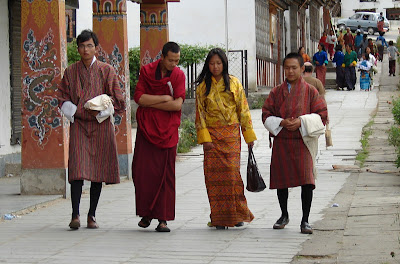So, let's continue the list of things unique to Bhutan with the local names:
When I arrived in Bhutan Dorji Tashi came to greet me at the airport. Then I went to the weekend market and met with someone from the Bhutanese television who introduced himself as Tashi Dorji. I started getting confused. Then, one day I met with a man with the name Sonam and the other day with a woman with the name Sonam. Then I met several other people and they were likely to have two of these names in various orders: Dorji, Sonam, Tashi, Karma, Phuntsho, Pema, Tshering, Sangay, Thinley, Ugyen, Jamtsho, Dawa, Wangchuk, or Tenzin. Some, like Loden entrepreneurs Pem and Namgay, only had one name.
Then I had a look at the Thimphu telephone directory that gives a glimpse of the high number of people who share names and I saw that they are differentiated by the residential, office or business address. For instance, Dorji Tshering, near Jitchu Drake Brakery and Dorji Tshering, Dept. of Culture. To appreciate the efforts of completing such a phone book, you also have to know that most streets have no names and houses are not numbered.
Then I learned a bit more about names:
The current king’s name is Jigme Khesar Namgyel Wangchuck and he is from the Wangchuck royal family. However, except for royal lineages, Bhutanese names do not include a family name. Instead one or two traditional auspicious names are chosen at birth by the local lama or by the parents or grandparents of the child. Names generally give no indication if the person is male or female, except some case like Wangmo which is a female name.
When a child is born, one or two names are given by a lama or a well-known monastery. According to traditional belief, a new born baby is named within three days after birth before evil spirits crawling around take the liberty of doing so. The pool of Buddhist Bhutanese names may be limited, less than a 100 as a rough estimate, but are steeped in meaning with religious roots like Hindu and Christian names. Bhutanese names are actually spoken phrases with some good meaning, they are optimistic and in some ways can be interpreted as good wishes for life.
Bhutanese also tend to have a name in their keykar or a birth chart given by the local astrologer when the chart is being drawn after the birth. The keykar normally contains details of the child’s previous life as another person or an animal, the general characteristics the child will have in the present life, difficult periods, likes and dislikes and details of marriage and children. The keykar name is not used at all except at the time of death of the person when it is pronounced for spiritual reasons.
To add to the confusion in a foreigner's mind, a name like Phuntsho, for example, can be spelled as Phuntshog, Phuntshok, Phintsho, Pintso, Finso, Funtsho, Pintsho, or Phuntsok. Not to mention small differences, largely due to the English translation, between a name written on a business card and the same person's email address, e.g. Sonam Jigme - sonamjigmi@... The influences from the outside are also having an impact on the Bhutanese name system and more and more people now adopt a common family title.
In Hungary, my nickname is Zoli and I prefer using this short name in Bhutan making it easier for people to remember. It is often pronounced as ‘dzolly’ and a monk told me that it means something like ‘in good shape’. I think I should be happy with this meaning.














